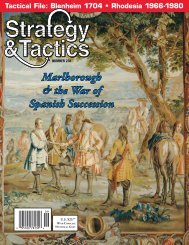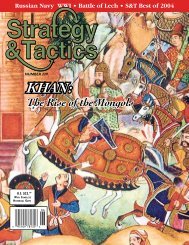COUNTERSTROKE AT SOLTSY - Strategy & Tactics Press
COUNTERSTROKE AT SOLTSY - Strategy & Tactics Press
COUNTERSTROKE AT SOLTSY - Strategy & Tactics Press
Create successful ePaper yourself
Turn your PDF publications into a flip-book with our unique Google optimized e-Paper software.
The Age of the Samurai<br />
The geographic isolation of Japan guarded the islands from invasion by the Mongol and<br />
Chinese Empires, and also shielded the Japanese from the influences of the wider world. As<br />
a consequence, Japan developed a unique political and military culture.<br />
Ancient Japanese society was theoretically based on the Confucian ideal of a central<br />
government ruled by an emperor. Those in the army were essentially armed civil servants,<br />
instruments of the state. In AD 684 a law was passed that made every peasant liable for<br />
military service in the rmperor’s army when required; however, that system broke down<br />
in periods of protected conflict. The Gempei War of the 12 th century, essentially a feud between<br />
powerful military families, resulted in Mimanota Yoritomo declaring himself Shogun<br />
(supreme barbarian-fighting general). In effect, the Shogun was military dictator.<br />
For the next several centuries, the Shogunate dominated the military and political<br />
spheres, with the emperor reduced to a shadowy figurehead. Under the Shogunate, troops<br />
were increasingly provided by daimyos (local nobility) from their retainers. Those retainers<br />
became the samurai military caste. In the latter part of the 16th century, Oda Nobunaga<br />
and Toyotomi Hideyoshi unified Japan with the usual bloodbath. Hideyoshi would go on<br />
to invade Korea and fight the Chinese in a pointless war. A brief civil war followed, with<br />
Tokugawa Ieyasu finally coming out on top. By the mid-17th century, the power of the<br />
Tokugawa Shogunate was such<br />
that peace and unity reigned in<br />
Japan until the coming of the<br />
Americans in 1854.<br />
Samurai Weapons & <strong>Tactics</strong><br />
“Samurai” literally means “one in service”, that<br />
is, a soldier. The Samurai traditionally carried two swords, the long<br />
(katana or tachi) and the short (wakizashi or tanto). Japanese blades were<br />
constructed from multiple strips of iron and steel. The former gave the blade<br />
flexibility, the latter its razor sharpness.<br />
The longbow was also a samurai weapon, and much was made of the art of<br />
skillfully drawing an arrow and firing. Interestingly, despite the length of the<br />
weapon, the Japanese bow was short ranged. Consequently, the Japanese were<br />
quick to take to the arquebus (an early musket) when they were introduced by<br />
European merchants in the 16th century.<br />
A wide array of spears and glaives, such as the naginata were also used.<br />
The latter were frequently carried by peasant soldiers, or ashigaru. Japanese<br />
cavalry were skilled in horse archery, though they frequently dismounted to<br />
fight.<br />
There is little evidence of military units such as European regiments in<br />
samurai armies. Instead, samurai and ashigaru apparently fought as warbands<br />
under the leadership of various daimyos.<br />
The samurai made much of individual combat, even in pitched battle, and<br />
the ideal was to fight the enemy’s champion. Nonetheless, skillful generals took<br />
a more disciplined approach, and tactics such as arquebus volley fire and the<br />
defense of field fortifications were common in Musashi’s era.<br />
strategy & tactics 55







